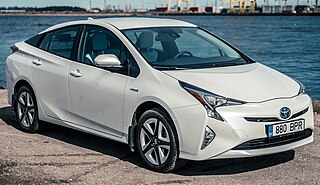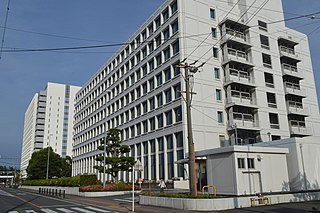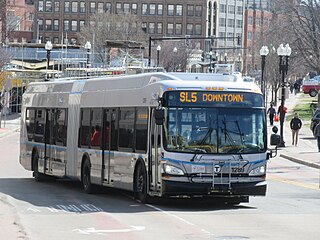Market research is an organized effort to gather information about target markets and customers: know about them, starting with who they are. It is an important component of business strategy and a major factor in maintaining competitiveness. Market research helps to identify and analyze the needs of the market, the market size and the competition. Its techniques encompass both qualitative techniques such as focus groups, in-depth interviews, and ethnography, as well as quantitative techniques such as customer surveys, and analysis of secondary data.

The Toyota Prius is a compact/small family liftback produced by Toyota. The Prius has a hybrid drivetrain, combined with an internal combustion engine and an electric motor. Initially offered as a four-door sedan, it has been produced only as a five-door liftback since 2003.

The General Motors EV1 is an electric car produced and leased by General Motors from 1996 to 1999. It was the first mass-produced and purpose-designed electric vehicle of the modern era from a major automaker and the first GM car designed to be an electric vehicle from the outset.

Automatic Data Processing, Inc. (ADP) is an American provider of human resources management software and services, headquartered in Roseland, New Jersey.

A green vehicle, clean vehicle, eco-friendly vehicle or environmentally friendly vehicle is a road motor vehicle that produces less harmful impacts to the environment than comparable conventional internal combustion engine vehicles running on gasoline or diesel, or one that uses certain alternative fuels. Presently, in some countries the term is used for any vehicle complying or surpassing the more stringent European emission standards, or California's zero-emissions vehicle standards, or the low-carbon fuel standards enacted in several countries.

Aisin Corporation is a Japanese corporation that develops and produces components and systems for the automotive industry. Aisin is a Fortune Global 500 company, ranked 359 on the 2020 rankings. Aisin is a member of the Toyota Group of companies.

A plug-in hybrid electric vehicle (PHEV) is a hybrid electric vehicle whose battery pack can be recharged by plugging a charging cable into an external electric power source, in addition to internally by its on-board internal combustion engine-powered generator. Most PHEVs are passenger cars, but there are also PHEV versions of sports cars, commercial vehicles, vans, utility trucks, buses, trains, motorcycles, mopeds, military vehicles and boats.

A hybrid electric vehicle (HEV) is a type of hybrid vehicle that combines a conventional internal combustion engine (ICE) system with an electric propulsion system. The presence of the electric powertrain is intended to achieve either better fuel economy than a conventional vehicle or better performance. There is a variety of HEV types and the degree to which each function as an electric vehicle (EV) also varies. The most common form of HEV is the hybrid electric car, although hybrid electric trucks, buses, boats and aircraft also exist.

Sport utility vehicles (SUVs) have been criticized for a variety of environmental and safety-related reasons. They generally have poorer fuel efficiency and require more resources to manufacture than smaller vehicles, thus contributing more to climate change and environmental degradation. Their higher center of gravity significantly increases their risk of rollovers. Their larger mass increases their momentum, which results in a larger braking distance and more damage to other road users in collisions. Their higher front-end profile reduces visibility and makes them at least twice as likely to kill pedestrians they hit. Additionally, the psychological sense of security they provide influences drivers to drive less cautiously or rely on their car for their perceived safety, rather than their own driving.
The 2008–2010 automotive industry crisis formed part of the 2007–2008 financial crisis and the resulting Great Recession. The crisis affected European and Asian automobile manufacturers, but it was primarily felt in the American automobile manufacturing industry. The downturn also affected Canada by virtue of the Automotive Products Trade Agreement.

The patent encumbrance of large automotive NiMH batteries refers to allegations that corporate interests have used the patent system to prevent the commercialization of nickel metal hydride (NiMH) battery technology. Nickel metal hydride battery technology was considered important to the development of battery electric vehicles, plug-in hybrid electric vehicles (PHEVs) and hybrid electric vehicles (HEVs) before the technology for lithium-ion battery packs became a viable replacement.

Subaru is the automobile manufacturing division of Japanese transportation conglomerate Subaru Corporation, the twenty-first largest automaker by production worldwide in 2017.
Smart is a German automotive marque. Smart Automobile Co., Ltd. is a joint venture established by Mercedes-Benz AG and Zhejiang Geely Holding Group in 2019 and aimed at producing Smart-badged cars in China to be marketed globally. The venture is headquartered in Ningbo. It produces small battery electric vehicles in their manufacturing plant in China, while previously the marque was known to produce microcars and subcompacts, primarily the Fortwo and Forfour, at Smartville in Hambach, Moselle, France and in the Revoz plant. Its distribution, marketing and aftersales activities in Europe are currently handled by smart Europe GmbH which is headquartered in Stuttgart, Germany.

The Toyota Prius Plug-in Hybrid is a plug-in hybrid liftback manufactured by Toyota. The first-generation model was produced from 2012 to 2016. The second-generation model has been produced since 2016. Production of the third-generation model began in 2023.

The 2009–11 Toyota vehicle recalls involved three separate but related recalls of automobiles by the Japanese manufacturer Toyota Motor Corporation, which occurred at the end of 2009 and start of 2010. Toyota initiated the recalls, the first two with the assistance of the U.S. National Highway Traffic Safety Administration (NHTSA), after reports that several vehicles experienced unintended acceleration. The first recall, on November 2, 2009, was to correct a possible incursion of an incorrect or out-of-place front driver's side floor mat into the foot pedal well, which can cause pedal entrapment. The second recall, on January 21, 2010, was begun after some crashes were shown not to have been caused by floor mat incursion. This latter defect was identified as a possible mechanical sticking of the accelerator pedal causing unintended acceleration, referred to as Sticking Accelerator Pedal by Toyota. The original action was initiated by Toyota in their Defect Information Report, dated October 5, 2009, amended January 27, 2010. Following the floor mat and accelerator pedal recalls, Toyota also issued a separate recall for hybrid anti-lock brake software in February 2010.
Bread Financial Holdings, Inc. is an American publicly-traded provider of loyalty and marketing services, such as private label credit cards, coalition loyalty programs, and direct marketing, derived from the capture and analysis of transaction-rich data.
Lexalytics, Inc. provides sentiment and intent analysis to an array of companies using SaaS and cloud based technology. Salience 6, the engine behind Lexalytics, was built as an on-premises, multi-lingual text analysis engine. It is leased to other companies who use it to power filtering and reputation management programs. In July, 2015 Lexalytics acquired Semantria to be used as a cloud option for its technology. In September, 2021 Lexalytics was acquired by CX company InMoment.
Donaldson Company, Inc. is a vertically integrated filtration company engaged in the production and marketing of air filters used in a variety of industry sectors, including commercial/industrial, aerospace, chemical, alternative energy (windmills) and pharmaceuticals. Also the company's research division, located in Minneapolis, Minn., participated in defense-related projects for various military applications.
Customer Acquisition Cost (CAC) is the cost of winning a customer to purchase a product or service. As an important unit economic, customer acquisition costs are often related to customer lifetime value.
CDK Global Inc. is an American multinational corporation based in Hoffman Estates, Illinois, providing data and technology to the automotive, heavy truck, recreation, and heavy equipment industries.











